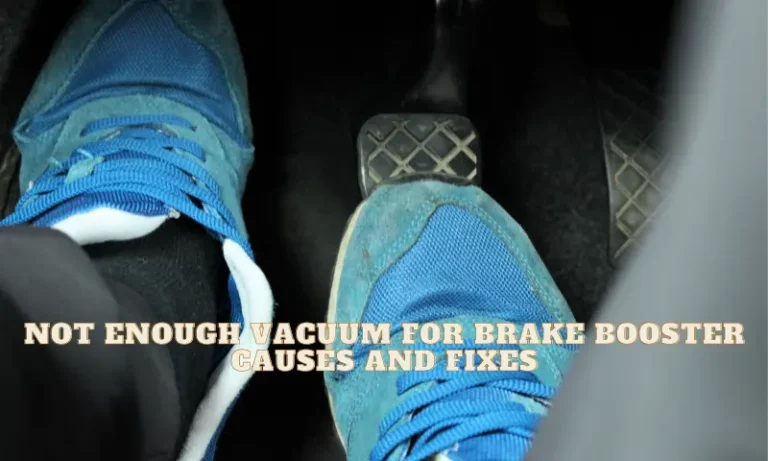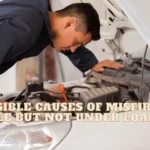A vacuum brake booster is one of the common forms of the brake booster. It increases the pressure applied to your brake pedal by relying on thegas-powered engine’s vacuum. Depending on your vehicle, your braking system may use the vacuum pump or hydraulic brake booster.
The thing is that auto problems are as wide as the sea’s perpetual flow. Each comes with different causes and solutions. I’ll be discussing one of those numerous troubles in this article, which is “Not Enough Vacuum for Brake Booster.” Before discussing the causes, how about briefly explaining what it means? Great!
“Not Enough Vacuum for Brake Booster” Explained
Most brake boosters cannot function without the engine vacuum. An excessive vacuum can lead to driveability issues while a low vacuum supply can affect the mph, diaphragm and, in turn, the brake pedal. Without the right vacuum, a brake booster will produce a harder brake pedal. You may have to increase the pressure on your brake pedal to activate your brake.
Various parts make up the brake booster. The diaphragm is one such. The diaphragm’s location is inside the brake booster. In addition to the pressure exerted when you press your brake pedal, the diaphragm pushes the pistons inside the master cylinder to activate your brake. The movement of the pistons down the master cylinder creates and supplies the amount of vacuum needed.
On the other hand, if there is not enough vacuum, the pedal becomes complicated, and your braking distance increases. As a matter of fact, the brake booster may become affected. Over time, it may also cause the engine to run lean with inadequate fuel in the cylinder.
Worthy of mention is that a vacuum booster is a difference between a vehicle designed with power steering and a manual steering car. If your car uses a pressured air system brake circuit, you may not need as much as autos with a hydraulic braking system.
Causes of Insufficient Vacuum for Brake Booster
For optimum operation, brake boosters need at least a 16″ vacuum. Here are some causes of inadequate vacuum for brake boosters.
- The notable cause of insufficient vacuum is a leak from the booster.
- The RPM of the engine.
- Lack of compression in the cylinder.
- A leak from the gaskets between the manifold and the carburetor.
- When you use a port smaller than the usual size, this prevents the engine from pulling an adequate amount of vacuum into the fittings.
- Condition and length of vacuum hose.
- The size of the booster can also affect the vacuum supply to the brake booster. If the booster size is not the standard size, perhaps, bigger than it should be, the system may tap out. Making the pedal hard to use.
- Leakage from the intake manifold gaskets.
- When you operate the vehicle at a higher altitude.
Symptoms of a Faulty Vacuum Brake Booster
There are signs your vehicle will display once it’s experiencing a ‘not enough vacuum brake booster.’ They include:
- Increased braking or stopping distance
- Warning anti-locking braking system, ABS
- Stiff brake pedal
- Poor engine performance and power
- Failed power steering
- Over-heated hydro-booster
“Not Enough Vacuum”- How to Fix
When your car displays “not enough vacuum for brake booster” it’s time to find a lasting solution. You must be careful, however, not to panic. A certified mechanic will do a better job than doing a DIY thing. Here is a step-by-step guide.
If you use a ⅜ fuel hose, change to an 11/32 vacuum hose.
- Check for any blockage in the hose. This can as well limit vacuum intake. Remove the hose attachment and clear all obstructions.
- Check the port in the manifold and ensure that it is ⅜” NPT and not smaller.
- Make sure you inspect the master cylinder to ascertain the working condition.
- Use the right size of the brake booster.
- Ensure your brake fluid is clean and good.
- You may need to install a canister or an electric vacuum pump if the brake booster is not receiving the right amount of vacuum. But first, confirm how far the vacuum pressure is compared to the usual number. A 16 to 18-inch vacuum is ideal.
- Carry out a vacuum test, to check the amount of vacuum the brake booster is receiving.
- Start by turning off the engine and disconnecting the hose from the booster.
- Connect a manometer to the end of the hose
- Turn on the engine
- While the engine gradually idles, read the vacuum’s magnitude.
- Compare the results on the gauge with the expected value on your vehicle manual.
- If the value you obtain is below standard, the problem will likely be a vacuum leak.
FAQs
What causes a low vacuum for brake booster?
Leakage from the vacuum hose or the intake manifold gasket can contribute to a low vacuum. Other causes can be a smaller port or a wrong booster size.
What happens if my car’s vacuum for the brake booster is not enough?
It will affect your brake pedal’s position, most likely, pushing it out of place. This makes it slightly higher than its original position.
Can a brake booster work without a vacuum?
Yes, I earlier told you that the type of brake booster depends on your vehicle type. Well, you can use a Hydro-Boost system. To do so, you must change to a hydraulic brake booster. A Hydraulic Brake Booster utilizes fluid pressure in place of a vacuum.
Final Thoughts
A vacuum leak could be why your system says Not Enough Vacuum For Brake Booster. If you take the issue with levity, you will be doing your vehicle a whole lot of harm. A vacuum leak allows air to overflow into the engine, which will have a marked effect on your engine performance.
This can be extremely difficult to fix, especially if you do not have the skill and the right tools needed. For this reason, you may have a qualified technician resolve the problem. If you need to replace some parts, ensure you make your findings before purchasing.



